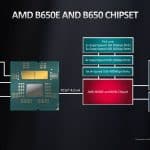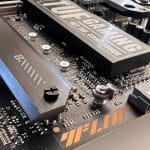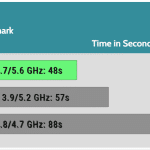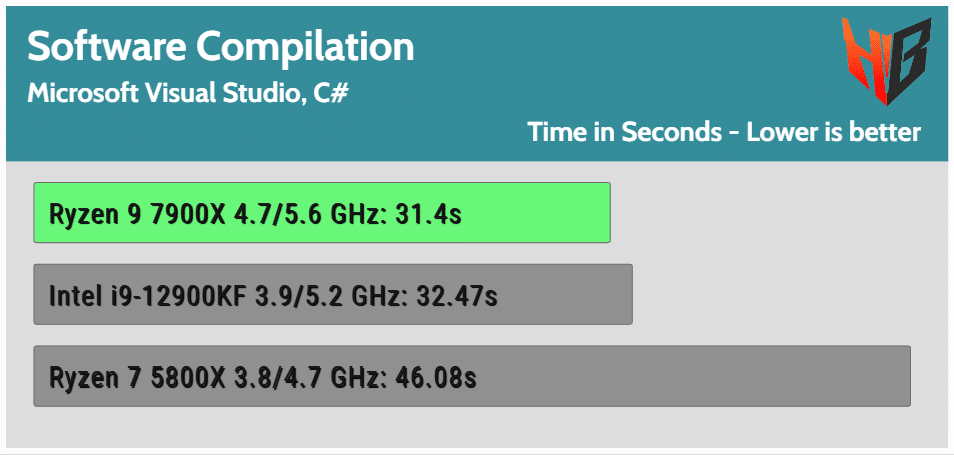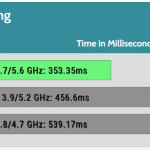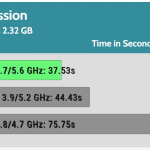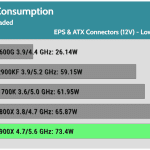The AMD Ryzen 9 7900x is a powerhouse. It doesn’t matter what you will throw at it, games or applications, it just won’t budge. This CPU is designed to run hot, so 95°C should not trouble you. On top of that, it needs a strong PSU, if you pair it with a potent GPU, since I measured up to 227W power power consumption.
With the release of AMD’s new Ryzen 7000 Zen4 series processors, with the codename Raphael, we have some significant changes from the Red team. After five years that the socket AM4 has been with us, we have a new socket, named AM5 (what a surprise!), supporting DDR5 memory and PCIe Gen 5 for both storage and graphics at the same time.
The new socket is powerful and capable of delivering up to 230W by utilizing a land-grid array (LGA), similar to what Intel has been doing for quite some time now. Finally, no more bent CPU pins, but you should be careful with the pins on the mainboard. The good news is that despite the new socket, there is compatibility with the existing AM4 coolers, so you won’t have to search for a new cooler or adapter bracket to use your old one.
AMD Zen4 Details
Similar to the Ryzen 5000 “Vermeer” CPUs and the older Ryzen 3000 series, we meet again a multi-chip architecture that tries to increase performance while keeping the production cost low. The CPU cores are inside CPU complex dies (CCDs), and the I/O control circuits are in a separate die. The CCDs utilize TSMC’s 5nm lithography, while the I/O dies use 6nm. This allows for lower production costs while performance is not affected since there is no need for the I/O die to use the most high-end lithography. The 7950x and 7900x use two CCDs, while the 7700x and 7600x use a single CCD.
Contrary to Intel, all cores in the AMD Zen4 are the same, so there is no distinction between performance and efficiency cores, which can confuse the software. Another interesting feature of Zen4 is the support for AVX-512, which increases the AI performance.
The new I/O die finally packs an RDNA2 iGPU. This and several other changes required lower 6nm lithography than the 12nm that the previous-gen cIOD used. The new IOD also includes a dual-channel DDR5 memory controller with ECC support. The embedded GPU is not for gaming purposes, and I guess most will buy such a powerful processor to combine it with a capable graphics card.
This scheme shows the features of the Radeon 610 iGPU that the AMD Zen4 CPUs utilize.
In general, all improvements on the Zen4 bring up to 13% IPC improvement, according to AMD’s claims. The front end, load/store, and branch prediction parts bring most of this performance gain. The execution engine and the L2 cache follow in improving the performance of the new processors. I won’t go into more detail about the Zen4 architecture since it’s been covered extensively already.
RAM Speeds
With the exclusive support of DDR5, RAM overclocking is an entirely different story. While in the previous generation, you had to keep the Infinity Fabric clock speed (FCLK), the memory controller (UCLK), and the memory clock (MCLK) at the same speeds, this is not the case anymore. You use AUTO settings for FCLK and the memory controller at 1:1 with the DRAM’s frequency. AMD states that DDR5-6000 is the “sweet spot,” so I changed my test system’s DDR5 RAM with an XPG DDR6400 kit.
A new overclocking profile called EXPO (Extended Profiles for Overclocking) is available, especially for AMD CPUs. This is identical to the Intel XMP. These RAM speed profiles offer a convenient way to achieve high RAM speeds without sweating. Compared to XMP profiles, the EXPO ones offer settings unique to AMD CPUs. Moreover, this is an open standard, so I expect most RAM manufacturers to adopt it soon. The XPG RAM (Caster 6400) I will use in this review includes EXPO profiles, so I will have the chance to try them out.
New Chipsets
You cannot have a new platform without introducing new chipsets, so say high to the X670(E) and the B650(E). The top X670 comes in two versions, with the one having the letter “E” at its end being the flagship version. They are the same, with the only difference being that the X670E offers PCIe 5.0 to the GPU, besides the Gen 5 NVMe interface. In the plain X670, the PEG is Gen 4, which doesn’t notably affect current GPUs’ performance. The same difference applies between the B650E and B650 chipsets.
The X670(E) has upstream and downstream chipsets, so basically is a two-chipset solution, while the previous X570 was a single chipset. The upstream chipset is connected to the AM5 SoC through a PCIe 4.0 x4 bridge, and the downstream chipset “talks” to the upstream one through the same type and amount of PCIe lanes. The B650(E) only has a single chipset and has half of the USB SuperSpeed ports that the X670(E) has.
Specifications
The impressive part is the official TDP which is set at 170W.
Product Photos
Test System
| Test System Specs | ||||
| Mainboard | ASUS TUF Gaming X670E-PLUS Bios Version 0821 (11/25/2022) |
|||
| CPU | AMD Ryzen 9 7900x (PBO Auto) |
|||
| GPU | AMD Radeon RX 6900XT | |||
| NVMe | XPG GAMMIX S50 Lite 1TB | |||
| RAM | XPG Caster (2 x 16GB) 6400MHz | |||
| Power Supply | Seasonic Vertex 1200W (Cybenetics Platinum) |
|||
| CPU Cooler | NH-D15S chromax.black | |||
| Case | DimasTech Bench | |||
| Ambient Temperature | 21°C ±3°C | |||
| Drivers | AMD: Adrenaline 22.20.42 | |||
This is the shining new test system for AMD processors. Besides the apparent mainboard change, I have also replaced the Corsair DDR5 5200 with faster XPG RAM. I did so because it was high time for faster RAM. This means that the results obtained with the slower Corsair RAM won’t be fully compatible with the ones I will get with the faster XPG RAM. I am totally aware of this, but in time I will make sure only to include results with the same RAM used.
I had to modify the PCIe extension board of the Powenetics system because the PCIe slot’s lock mechanism was in the way.
Test Results
Synthetic Benchmarks
AIDA 64 CPU Benchmarks, Digital Photo Processing, Encryption & Hashing
Rendering
In Blender, I use the BMW 27 scene. The Corona Renderer might be old, but it still provides valuable insights into the CPU’s rendering capabilities.
Davinci Resolve is one of the best video editing apps, even in its free version. I use it to extract a 4K video without utilizing the GPU’s capabilities.
Software Development
I compile a large project in Microsoft’s Visual Studio to evaluate all CPUs.
Web Browser Performance
The Google Octane 2.0 tests show the performance of the JavaScript engine. The Mozilla Kraken is similar to the Octane, measuring the execution time of the JavaScript code.
AI – Machine Learning
To fully utilize a machine’s capabilities and solve complex problems, you must train it. The more data you feed it during training, the better becomes its neural network, which is the one that will provide the final results. Tensorflow is based on Python and has been developed by Google. It supports both CPUs and GPUs, but I will only use its CPU support in my case.
Productivity and Microsoft Office
I use the PCMark10 benchmark suite to evaluate all CPUs under several productivity tasks. I also use the Applications Benchmark, which uses all Microsoft Office apps.
Data Compression
I use two popular compression apps, WinRar and 7-zip. Both have embedded benchmarks, and I also compress a large file folder with WinRar.
Media Encoding
I convert a 4K video to HD format with 30 frames per second with Handbrake, using three different compression algorithms.
Puget Benchmarks
Puget is a PC-building company specializing in video editing systems. To evaluate their systems, they’ve created several benchmark tests for popular video and photo editing applications. They were also kind enough to provide free (and paid) versions of them to the rest of the world.
HD Game tests
Using a potent GPU at low resolutions, I ensure there is no bottleneck in this section to check the CPU performance differences easily—all games run at HD resolution and the highest possible setting, without RTX.
Power Consumption
I use the Powenetics system to measure power consumption in every significant part of the mainboard, with up to 1000 readings per second.
Peak Power Consumption
I obtained the peak power consumption readings shown in the graph above during the start of the Prime95 benchmark.
Energy Usage
Besides power consumption, I also look at the energy usage of each CPU to see how efficient they are; by calculating the total amount of power required to finish two tasks, a Super Pi run indicative of single-threaded applications and a Cinebench run for multi-threaded scenarios.
Max Operating Temperature
To check the operating temperatures, I run Blender instead of Prime95 and small FFTs, which apply an unrealistically high load to the CPU.
According to AMD, the 7000 series can run all day at 95C without any issues. From default, the max temperature limit was set at 95C, and as you can see in the graph above, the CPU can reach it during a demanding benchmark, even with a strong cooling solution like the Noctua NH-D15S.
Asus allows you to set lower max temperatures if you don’t want to see 95C, and there is an excellent article about it showing the effect on performance. You will find it here.
Overclocking
I’ve tried hard to achieve something better in benchmarks through manual overclocking. Still, in the limited time I had to finish this review, I didn’t manage anything worthy, so I advise you to enable PBO and apply an EXPO RAM profile and don’t lose time. You will probably make things worse rather than achieve higher performance. Moreover, these CPUs run hot, so the limit is set by the cooling solution you will use. Even the mighty Noctua NH-D15S met its match in the 7900X.
Overall & Gaming Performance
The performance difference is notable. With DRAM at 5200MHz, the difference with the 12900KF will be smaller but still significant. In gaming, the 5800x is still strong and is currently sold at a bargain price.
Performance per Dollar – ALL CPU Tests & Gaming
The good price of the Ryzen 7 5800x skyrockets its performance per buck score in both charts. The deal gets even better if you add the lower cost of the AM4 mainboards and DDR4 RAM.
Epilogue
AMD topped the performance charts with the Ryzen 7000 series in both applications and games. I haven’t yet tested the Intel 13900K, which according to the test results of other editors, is the performance king everywhere, topping even the Ryzen 7950x, but soon (or later), it will be added to my charts. Unfortunately, I don’t have any contacts with Intel, so I have to buy all Intel CPUs and the required hardware.
Let’s talk about prices. The Intel i9-13900K at the review time is sold at $600, while the Ryzen 9 7950x is $10 more affordable. The i7-13700K goes for $422, and the 7900x has a similar price tag. This shows that Intel is going strong after AMD (or it is the other way around). Performance-wise, the boost from the 5000 series is impressive, but I am a little skeptical about the high operating temperatures. AMD assures buyers that the Raphael processors can operate all day at 95 degrees Celsius for years without any issues, but the fact is that such a high TDP CPU applies massive stress to the cooling system. This means increased fan speeds, leading to higher noise output.
Moreover, the higher the speeds of the moving parts of the cooling systems, the more prone they are to failure. The high power consumption issue is more evident in Intel processors, especially the 13900K, so this is something that both AMD and Intel should try to rectify in their future products. We already have 500-600W GPUs, with the power excursions excluded, and 200-400W CPUs on top. This means that for a high-end system and a bit of overclocking, a 1000W PSU will be the borderline! I know that performance is also much higher, as shown in the multi-threaded Energy Usage graph, where the 7900x takes the lead from the highly efficient Ryzen 5 5600G CPU. In single-threaded apps, it scores last, though. The good thing is that today’s apps are coded to utilize multiple cores and not just a single one, so at a point, it will be pointless for me to measure single-thread energy usage.
The Ryzen 9 7900x must be combined with high-speed DDR5 RAM, with the sweet spot being 6000MHz, to have FCLK at 2000MHz. This is why I had to change my test set-up system’s RAM configuration and utilize a speedy DDR5 RAM kit that XPG was kind to provide. You will also need a strong cooling solution, and the compatibility with AM4 socket’s coolers is a blessing since you won’t have to order extra parts or a new cooler. AMD doesn’t ship the 7900x with a stock cooler, probably because this would heavily affect its price, given that it needs high-end cooling to deploy its full potential. Given its cooling needs, there is no point in overclocking or increasing the multiplier unless you plan to run it with an extreme cooling solution.
The new AMD platform looks nice and will be even more stable through more BIOS and driver updates. I have to admit that I encountered some problems while pushing the RAM higher. At some periods, everything worked fine, but after a reboot, I got window error codes. Thankfully, I didn’t encounter any windows corruption problems, but I expected to see a more stable platform. My XPG RAM kit might not be ideal for the 7900x or the ASUS TUF mainboard I used, or I also need more time to fine-tune the platform, which I don’t have. For me, the ideal usage scenario is to install everything, set PBO at auto, use an EXPO RAM profile, and boot without any issues. However, this is not as easy as it sounds on an entirely new platform. If I wanted to jump on the DDR5 wagon, I would have a hard time choosing between the 7900x and the 13700K. I hope to have the latter in my charts at some point.
- High performance
- PCIe 5.0 support for both storage and graphics
- Integrated GPU
- AM5 retains cooling compatibility with AM4
- Unlocked multiplier
- DDR5 support
- AVX512 and AI instructions support
- Requires strong cooling
- Increased platform cost
- No CPU cooler included in the bundle












